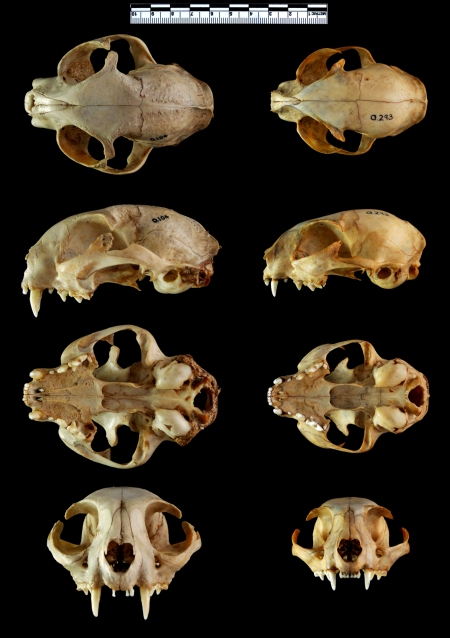This week I thought I should mop up the last of the smaller cats as a spot-the-difference:
What do you think are the diagnostic features that separate these two skulls (bonus points for species identifications)?
I’m really keen to get your thoughts on this, so please put your observations in the comments section below. Thanks!


On the right is a Felis catus. On the left is something slightly larger; about the size of a Margay (but not one).
Some observations:
The auditory bullae of the F.c. are comparatively larger than the other specimen.
There are distinct shape differences in the supra-orbital processes and those of the F.c. point more to the rear. While the F.c. skull widens behind these, the other narrows briefly before widening again.
The zygomatic arch appears to arch slightly higher in the left specimen.
The F.c. skull is slightly more domed.
Great observations – thanks!
Another observation (though not so much a diagnostic) which may explain some of the above observations:
It seems that if the species of cats are arranged in increasing size order, then the anterior half of the skull (forward of the frontal-parietal suture) seems to increase in size more than the posterior half. Strange.
And I meant ALL species of cats, not just these two.
I wonder if this might relate to scaling of the temporalis muscle cross-sectional area and corresponding increase in loading of the anterior dentition as a result of the volumetric size increase in relation to the linear increase seen in skull length. If that makes any sense…
So basically I’m suggesting that scaling can’t be isometric due to constraints imposed by the relatively fixed mechanical properties of bone and muscle.
Hmm, I think I’d expect the scaling constraint to work in the opposite direction — relatively smaller jaws for a given skull size.
Does this occur in any other families – canids, primates?
Some quick measurements on some small mustelids (weasel, stoat, ferret) also suggests increased relative length of the anterior portion of the skull as size increases.
A pattern emerges!
I’m not going to try to identify species.
As to diagnostic differences… One is significantly BIGGER than the other.
The other things I noticed were both in the top view. In the larger skull, the rear end of the frontals narrow a bit before reaching the suture with the parietals. (Or, as henstridgesj described it, “While the F.c. skull widens behind these, the other narrows briefly before widening again.”)
And the larger skull seems to show an “incipient” sagital crest (on the forward part of the parietals) whereas the smaller one has a smooth dome. (My impression is that the presence and development of sagital crests, among felidae, correlates pretty strictly with size.)
Oh. And the nasals have slightly different shape: in the larger skull they are pretty much triangular, narrowing at a constant rate as you move caudad, where as in the smaller there is something of a “neck”: at the front there is a rapid narrowing, then there is a region where the outer sides are closer to parallel (though not fully parallel: the nasal is still narrowing but not as much), before narrowing to a point. (Mathematically speaking: in both, the nasal narrows monotonically as you go caudad, but whereas in the larger skull the rate of narrowing is pretty close to constant, in the smaller it has a couple of dramatic changes.) (This one visible both in top view and in front view.)
Great stuff! I’m always wary of the sagittal crest – it can vary so much within a species that I seldom trust it as a diagnostic feature. Those nasals do look substantially different, which is interesting.